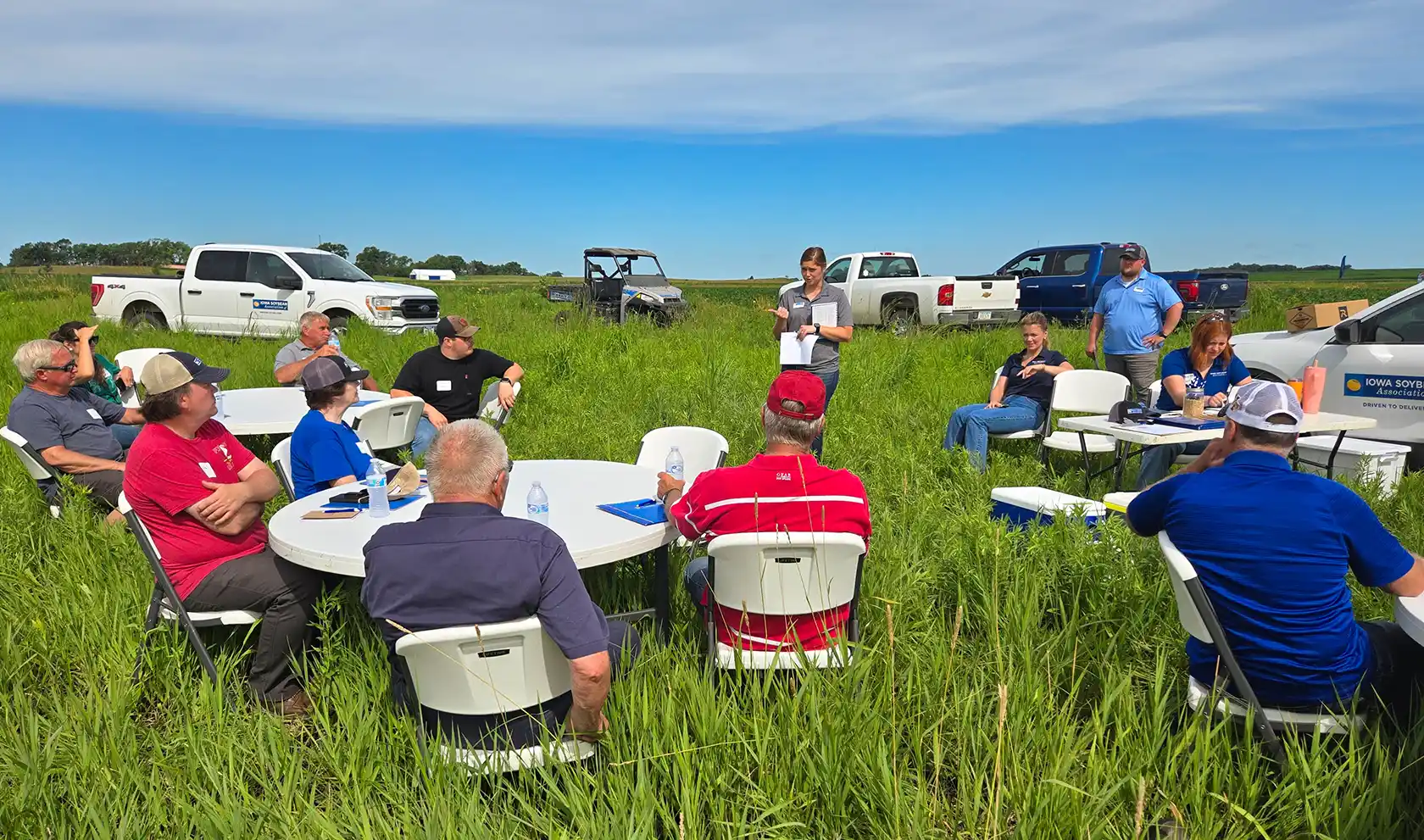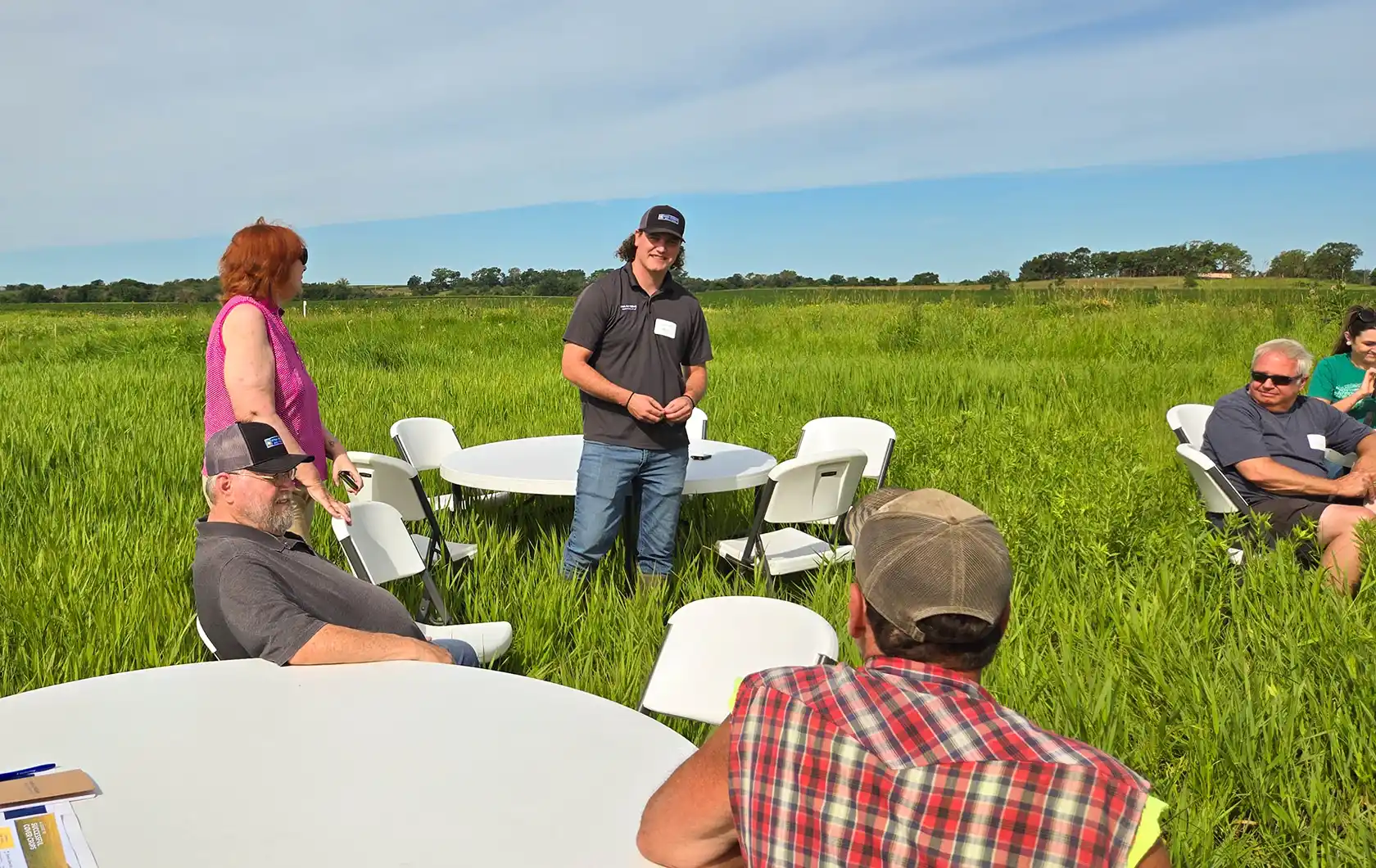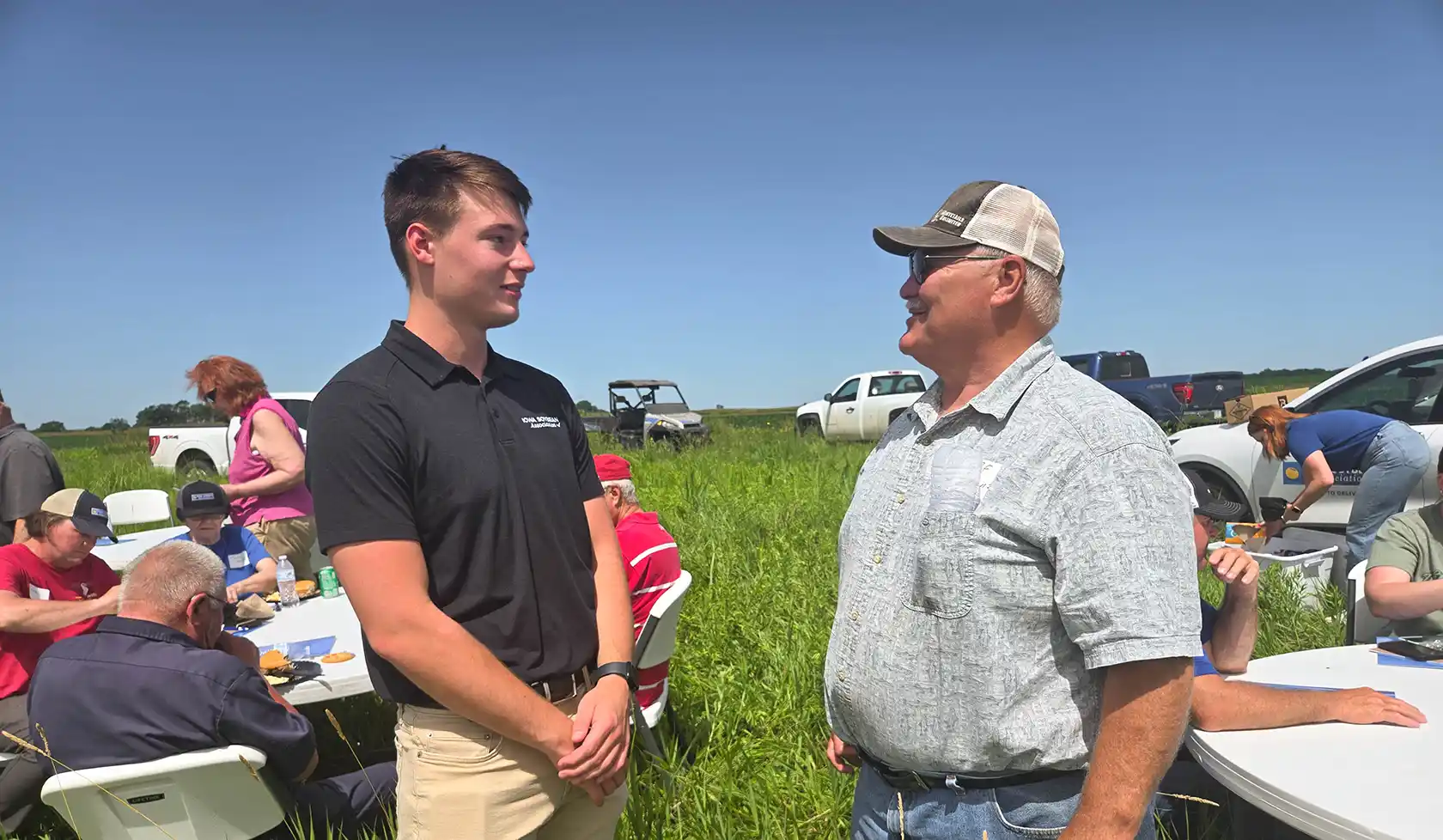
(Photo: Iowa Soybean Association / Kriss Nelson)
Innovation to Profit Field Day showcases wetland restoration success
July 9, 2025 | Kriss Nelson
With a restored wetland in the background, two fawns grazing among tall grasses and birds chirping set the scene for an Iowa Soybean Association (ISA) Innovation to Profit field day on Tuesday at David and Kathy Law’s farm.
Once low and unproductive areas of cropland in Carroll County, a thriving wetland and restored oxbows are now home to ducks, geese and even the endangered Topeka shiner.
“This area naturally floods with the amount of drainage coming into it,” says Brandon Iddings, ISA senior conservation services manager. “It’s a low-lying, unproductive spot that lost money, so it made sense to take it out of production.”
ISA and the United States Fish and Wildlife Service approached the Laws to help them restore four oxbows. Their wetland project was done through a Conservation Research Enhancement Program (CREP) working with the Iowa Department of Agriculture and Land Stewardship (IDALS) and the U.S. Department of Agriculture (USDA).
“This ground really wasn’t very productive,” Kathy Law says. “A wetland just made more sense for how it could be used. We’re concerned about nitrates in the water, and we know all farmers care about the land. We want to do the right things and put the right practices in place.”
From start to finish, Law said the process of restoring the wetland and oxbows was easy thanks to the partners involved.

Brandon Iddings and Kathy Law talking about conservation efforts.
“They really made it easy,” she says. “We had people meeting with us all the time, we had everyone’s phone numbers, and they provided all the paperwork and clear explanations.”
The family was included in the planning and design.
“We got to sit in on the engineering meetings and give input on the plans,” she adds. “They kept us informed every step of the way.”
Today, the restored wetland is more than just a project; it’s a place where the family enjoys spending time. Soon, they will enjoy the yellow blooms of thousands of Goldenrod plants.
Plants like Goldenrod bloom in late summer, aiding late-season pollinators.
“We like coming out here and watching the wildlife,” Law says. “We see all kinds of different birds we never used to see, and there are ducks and geese on the pond. It’s just really nice having it here now.”
As part of the project, oxbows were restored on the property to help improve water quality and habitat. One exciting outcome was the return of an endangered fish species.
“When we first went and looked, there were no Topeka shiners,” Law says. “But about a month ago, we found our first population. That was really exciting.”
The Law family has farms in Carroll and Greene Counties. The wetland site was added to the operation in 1991, with the wetland created in 2017-2018.
“My mom and dad bought this piece in ’91, but the farm to the west has been in the family since probably the ’30s or ’40s,” she says.
By hosting tours and sharing their experience, the Law family hopes to inspire other farmers to consider similar conservation projects.
“We’re happy to let people come out and see what we’ve done,” she says. “If it encourages someone else to do something like this, then that’s a win for all of us.”
Conservation making an impact
Iddings explained the effects that projects, such as wetlands, can have.
“This wetland is receiving drainage from just under 700 acres of cropland,” says Iddings. “That means a lot of opportunity for nitrate removal, which is one of the main goals of Iowa’s Nutrient Reduction Strategy.”
Wetlands are designed to allow plants and microbes in the soil to absorb nitrates before the water continues downstream. According to Iddings, the program has proven to be successful.
“These wetlands are treating about 50% of the nitrate that comes into them,” he says. “That’s a pretty significant reduction and a big win for water quality.”
Landowners who participate in projects like this can receive financial incentives through the CREP. That includes both annual easement payments and cost coverage for excavation and construction.
“When you can get the ground into a CREP easement, you’re getting a good payment,” says Iddings. “And the state helps fund the practice itself, from the dirt work to any infrastructure needed.”
Conservation fit for a farmer
The most effective conservation is site-specific, considering both the land itself and the landowner's circumstances.
“We try to fit these practices to the farmer’s goals and make sure they work for everyone,” Iddings says. “If you’re interested in fishing, for example, a deeper section of the wetland can be designed to support that while still meeting water quality goals. It really comes down to what fits your operation. There are options, and the support is there to help make it work.”
Farm to River Partnership
The field day was held in the heart of the Farm to River Partnership, a water quality initiative started in 2018 to increase conservation farming practices on the land for improved water quality in the North Racoon Watershed.
“We have a big footprint out here with a large focus of the partnership on in-field conservation, such as cover crop promotion,” says Joe Wuebker, ISA conservation agronomist and Farm to River Partnership coordinator.
Recently, the Farm to River Partnership introduced a new project, expanding the partnership further into Sac and Greene Counties.
The expanded project will focus on increasing the adoption of in-field water and soil quality practices such as cover crops, reduced tillage and nitrogen stabilizers as well as edge-of-field practices like saturated buffers, bioreactors, oxbows and wetlands. These efforts are part of the Batch and Build project in Sac County, which aims to achieve cost-effective installations of conservation practices by grouping sites geographically.
Wuebker reminded the group of farmers ISA’s conservation services and program team are available to assist farmers in their conservation efforts.
“We’re trying to streamline this process. So, you don’t have to have multiple visits to an office and understand funding sources available,” he says. “We are trying to make this as simple as possible.”

Churdan farmer Jeff Pudenz shares his perspective with ISA Conservation Services Manager Alex Buseman.
A farmer’s perspective
Standing near the Law family’s wetland, ISA farmer member Jeff Pudenz reflects on the land’s transformation.
“I was born and raised in this area and drove by here a lot over the years. It used to flood out most of the time. We used to call this kind of land ‘worthless,’” he says. “Now, we’re seeing what it can really do.”
Pudenz, a farmer from Churdan, is passionate about conservation and understands the obstacles involved in getting farmers more into the conservation space.
“In the past, if you talked to the average farmer about conservation, they didn’t want anything to do with it,” says Pudenz. “They’ve been burned before. And when a farmer says they’ve been burned, that means ‘never, ever again.’ It’s that fool-me-once, fool-me-twice kind of thing.”
Pudenz got his start in conservation back in the 1970s as a junior conservationist. Decades later, he’s still a firm believer in its value, not just for the land, but for a farmer’s bottom line.
“Everyone’s always talking about getting more acres,” he says. “But no. You don’t need more acres. You need to be more efficient with the ones you’ve got. Conservation is about making the most with what you have.”
Pudenz sees ISA’s conservation efforts as a “breath of fresh air.”
“There were times I felt like I had to jump through a million hoops just to make something work,” he says. “That’s why having someone like Brandon made a huge difference. Brandon’s the kind of guy who says, ‘If I can’t do it, I’ll find someone who can.’ That’s huge for a farmer.”
Pudenz believes that the most conservation-minded farmers are often the most successful.
“There are so many benefits to this work—the wildlife, the native grasses coming back—but for the farmer, it’s also about the money,” he says. “When I talk to farmers, I tell them this isn’t just good for the land, it’s a money-making deal. If you’re in it for the long term, it’s even better.”
Written by Kriss Nelson.
Back